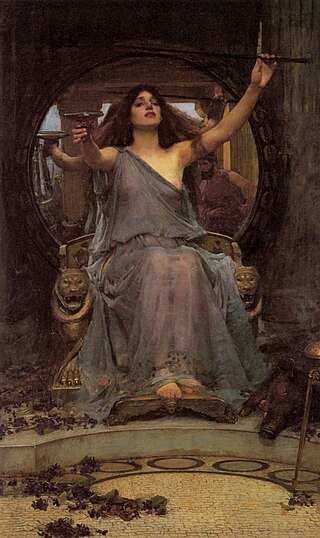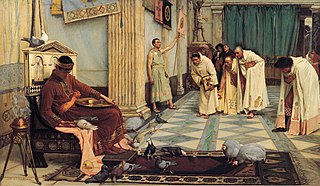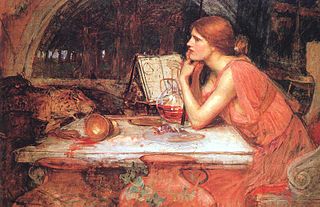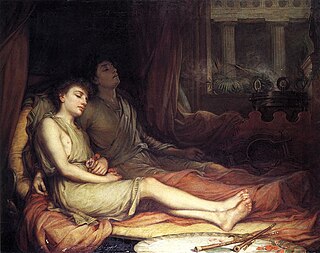
Delphi, in legend previously called Pytho (Πυθώ), was an ancient sacred precinct and the seat of Pythia, the major oracle who was consulted about important decisions throughout the ancient classical world. The ancient Greeks considered the centre of the world to be in Delphi, marked by the stone monument known as the omphalos (navel).

Pythia was the name of the high priestess of the Temple of Apollo at Delphi. She specifically served as its oracle and was known as the Oracle of Delphi. Her title was also historically glossed in English as the Pythoness.

In Greek mythology, Python was the serpent, sometimes represented as a medieval-style dragon, living at the center of the earth, believed by the ancient Greeks to be at Delphi.
The sibyls were prophetesses or oracles in Ancient Greece. The sibyls prophesied at holy sites. A sibyl at Delphi has been dated to as early as the eleventh century BC by Pausanias when he described local traditions in his writings from the second century AD. At first, there appears to have been only a single sibyl. By the fourth century BC, there appear to have been at least three more, Phrygian, Erythraean, and Hellespontine. By the first century BC, there were at least ten sibyls, located in Greece, Italy, the Levant, and Asia Minor.

John William Waterhouse was an English painter known for working first in the Academic style and for then embracing the Pre-Raphaelite Brotherhood's style and subject matter. His artworks were known for their depictions of women from both ancient Greek mythology and Arthurian legend.

The Art of the United Kingdom refers to all forms of visual art in or associated with the United Kingdom since the formation of the Kingdom of Great Britain in 1707 and encompasses English art, Scottish art, Welsh art and Irish art, and forms part of Western art history. During the 18th century, Britain began to reclaim the leading place England had previously played in European art during the Middle Ages, being especially strong in portraiture and landscape art.

The Delphic Sibyl was a woman who was a prophet associated with early religious practices in Ancient Greece and is said to have been venerated from before the Trojan Wars as an important oracle. At that time Delphi was a place of worship for Gaia, the mother goddess connected with fertility rituals that are thought to have existed throughout the ancient Mediterranean world. As needed to maintain the religious tradition, the role of sibyl would pass to another priestess at each site.

The Persian Sibyl – also known as the Babylonian, Chaldaean, Hebrew or Egyptian Sibyl – was the prophetic priestess presiding over the Apollonian oracle.

Echo and Narcissus is a 1903 oil painting by John William Waterhouse. It illustrates the myth of Echo and Narcissus from Ovid's Metamorphoses.

Circe Offering the Cup to Ulysses is an oil painting in the Pre-Raphaelite style by John William Waterhouse that was created in 1891.

The Magic Circle is an 1886 oil painting in the Pre-Raphaelite style by John William Waterhouse. Two copies of the painting were produced. The paintings and a study depict a witch or sorceress using a wand to draw a fiery magic circle on the Earth to create a ritual space for her ceremonial magic. As was common in the period, Waterhouse repeated his subject on a smaller scale, probably at the request of a collector.

Circe Invidiosa is a painting by John William Waterhouse completed in 1892. It is his second depiction, after Circe Offering the Cup to Ulysses (1891), of the classical mythological character Circe. This particular mythological portrayal is based on Ovid's tale in Metamorphoses, wherein Circe turns Scylla into a sea monster, solely because Glaucus scorned the enchantress' romantic advances in hopes of attaining Scylla's love instead. Waterhouse later returned to the subject of Circe a third time with The Sorceress (1911). Circe Invidiosa is part of the collection of the Art Gallery of South Australia, which also owns Waterhouse's 1883 The Favourites of the Emperor Honorius.

The Favourites of the Emperor Honorius is a painting by John William Waterhouse completed in 1883. The painting depicts Honorius feeding birds which are on the rug in front of him; the dark colours of the rug and his clothes define a space. Separated from him and the birds are the councillors seeking his attention, and who along with the attendant are dressed in paler shades.

The Unwelcome Companion: A Street Scene in Cairo is an early painting by John William Waterhouse. Completed in 1873, it was exhibited at the gallery of the Society of British Artists.

The Crystal Ball is a painting by John William Waterhouse completed in 1902. Waterhouse displayed both it and The Missal in the Royal Academy of 1902. The painting shows the influence of the Italian Renaissance with vertical and horizontal lines, along with circles "rather than the pointed arches of the Gothic".

The Sorceress is an oil-on-canvas painting by the English artist John William Waterhouse completed between 1911 and 1915. It is his third depiction, after Circe Offering the Cup to Ulysses (1891) and Circe Invidiosa (1892), of the Greek mythological character, Circe, and her name is on the back of the canvas. The inclusion of leopards and the loom offer further evidence that the painting is of Circe.

Sleep and His Half-Brother Death is a painting by John William Waterhouse completed in 1874.

In Greek mythology, Manto was the daughter of the prophet Tiresias and mother of Mopsus. Tiresias was a Theban oracle who, according to tradition, was changed into a woman after striking a pair of copulating snakes with a rod, and was thereafter a priestess of Hera.

Ulysses and the Sirens is an 1891 painting by the Pre-Raphaelite artist John William Waterhouse. It is currently held in the National Gallery of Victoria, Melbourne, Australia.



















